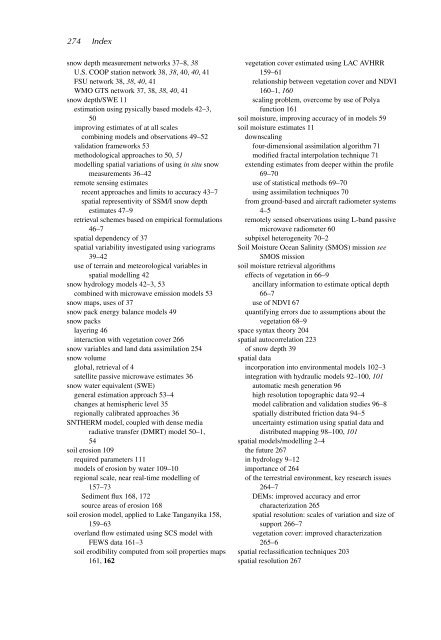1 Spatial Modelling of the Terrestrial Environment - Georeferencial
1 Spatial Modelling of the Terrestrial Environment - Georeferencial
1 Spatial Modelling of the Terrestrial Environment - Georeferencial
You also want an ePaper? Increase the reach of your titles
YUMPU automatically turns print PDFs into web optimized ePapers that Google loves.
274 Index<br />
snow depth measurement networks 37–8, 38<br />
U.S. COOP station network 38, 38, 40, 40, 41<br />
FSU network 38, 38, 40, 41<br />
WMO GTS network 37, 38, 38, 40, 41<br />
snow depth/SWE 11<br />
estimation using pysically based models 42–3,<br />
50<br />
improving estimates <strong>of</strong> at all scales<br />
combining models and observations 49–52<br />
validation frameworks 53<br />
methodological approaches to 50, 51<br />
modelling spatial variations <strong>of</strong> using in situ snow<br />
measurements 36–42<br />
remote sensing estimates<br />
recent approaches and limits to accuracy 43–7<br />
spatial representivity <strong>of</strong> SSM/I snow depth<br />
estimates 47–9<br />
retrieval schemes based on empirical formulations<br />
46–7<br />
spatial dependency <strong>of</strong> 37<br />
spatial variability investigated using variograms<br />
39–42<br />
use <strong>of</strong> terrain and meteorological variables in<br />
spatial modelling 42<br />
snow hydrology models 42–3, 53<br />
combined with microwave emission models 53<br />
snow maps, uses <strong>of</strong> 37<br />
snow pack energy balance models 49<br />
snow packs<br />
layering 46<br />
interaction with vegetation cover 266<br />
snow variables and land data assimilation 254<br />
snow volume<br />
global, retrieval <strong>of</strong> 4<br />
satellite passive microwave estimates 36<br />
snow water equivalent (SWE)<br />
general estimation approach 53–4<br />
changes at hemispheric level 35<br />
regionally calibrated approaches 36<br />
SNTHERM model, coupled with dense media<br />
radiative transfer (DMRT) model 50–1,<br />
54<br />
soil erosion 109<br />
required parameters 111<br />
models <strong>of</strong> erosion by water 109–10<br />
regional scale, near real-time modelling <strong>of</strong><br />
157–73<br />
Sediment flux 168, 172<br />
source areas <strong>of</strong> erosion 168<br />
soil erosion model, applied to Lake Tanganyika 158,<br />
159–63<br />
overland flow estimated using SCS model with<br />
FEWS data 161–3<br />
soil erodibility computed from soil properties maps<br />
161, 162<br />
vegetation cover estimated using LAC AVHRR<br />
159–61<br />
relationship between vegetation cover and NDVI<br />
160–1, 160<br />
scaling problem, overcome by use <strong>of</strong> Polya<br />
function 161<br />
soil moisture, improving accuracy <strong>of</strong> in models 59<br />
soil moisture estimates 11<br />
downscaling<br />
four-dimensional assimilation algorithm 71<br />
modified fractal interpolation technique 71<br />
extending estimates from deeper within <strong>the</strong> pr<strong>of</strong>ile<br />
69–70<br />
use <strong>of</strong> statistical methods 69–70<br />
using assimilation techniques 70<br />
from ground-based and aircraft radiometer systems<br />
4–5<br />
remotely sensed observations using L-band passive<br />
microwave radiometer 60<br />
subpixel heterogeneity 70–2<br />
Soil Moisture Ocean Salinity (SMOS) mission see<br />
SMOS mission<br />
soil moisture retrieval algorithms<br />
effects <strong>of</strong> vegetation in 66–9<br />
ancillary information to estimate optical depth<br />
66–7<br />
use <strong>of</strong> NDVI 67<br />
quantifying errors due to assumptions about <strong>the</strong><br />
vegetation 68–9<br />
space syntax <strong>the</strong>ory 204<br />
spatial autocorrelation 223<br />
<strong>of</strong> snow depth 39<br />
spatial data<br />
incorporation into environmental models 102–3<br />
integration with hydraulic models 92–100, 101<br />
automatic mesh generation 96<br />
high resolution topographic data 92–4<br />
model calibration and validation studies 96–8<br />
spatially distributed friction data 94–5<br />
uncertainty estimation using spatial data and<br />
distributed mapping 98–100, 101<br />
spatial models/modelling 2–4<br />
<strong>the</strong> future 267<br />
in hydrology 9–12<br />
importance <strong>of</strong> 264<br />
<strong>of</strong> <strong>the</strong> terrestrial environment, key research issues<br />
264–7<br />
DEMs: improved accuracy and error<br />
characterization 265<br />
spatial resolution: scales <strong>of</strong> variation and size <strong>of</strong><br />
support 266–7<br />
vegetation cover: improved characterization<br />
265–6<br />
spatial reclassification techniques 203<br />
spatial resolution 267

















